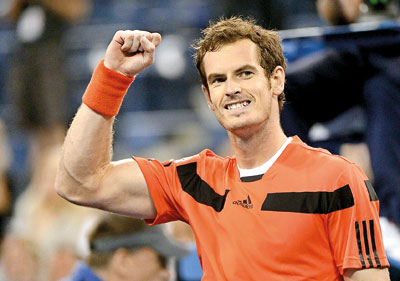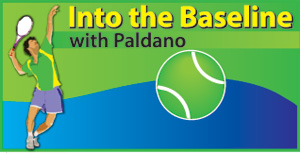ATP and WTA as world ‘Tennis indicators’
View(s):What is the ‘indicator’ to confirm that a nation or an individual is in the Tennis-map of the world? It is the end of the Tennis season for 2016 and this aspect has become a hot topic. The prospects of recognition as a Tennis-nation do not seem to be good for most of the countries as the ‘indicator’ points to a shrinking list of nations in world rankings. For many nations, Tennis has become a school level age group seasonal sport than a pursuit for professional excellence. This approach will have no impact on the ‘indicator’.

Andy murray
Last week in London, the best of the men’s Tennis players began their show down. The new World’s number one Britain’s Andy Murray with only a slender lead, will ‘have to win’ to keep his position. Serbia’s Djokovic the man whom Murray displaced is not far behind in his challenge to regain the number one position. In seems like in the first few days Djokovic is on track to regain his crown. The lead Murray has in a complicated calculation narrowed down to a mere 150 points before this event. It is this professional aura that is keeping Tennis in the Global news and no other.
The stage for this drama is set by the Association of Tennis Professions (ATP) and not by any National Associations of countries. Since 1973 the ATP has steadily grown and now it is a ‘Tennis-empire’ of the players with the Women’s Tennis Association (WTA) as the counterpart for women. This event in London known as the ATP masters is the 45th of its legacy. WTA concluded its event a few weeks ago in Singapore.
Money
Tennis always had money and the scramble to manage Tennis in nations was never only because of the passion administrators had for the game, but mostly for the access to the money and perks. In good many cases it is only for these. Now the ‘kitty’ is even bigger. Who made the money in the past is arguable and in the seventies players decided that they should also be getting a better share. The ATP and the WTA popularly referred to as professional bodies, were their answer. It created an inlet into the Tennis ‘treasure trove’ successfully.
 The original Global Tennis promoting body was the International Tennis Federation (ITF) inaugurated way back in the early 20th century. They still have around 200 national bodies, like Sri Lanka’s, affiliated to them. For all practical purposes one could almost say their ‘reign is waning’. There is no such thing as an affiliation of countries into the ATP or the WTA. It is ‘player dominated’ and they look after the interest of the ‘elite players’ at any time. They have no respect for local designs, sanctions and suspension of such bodies. To participate in their events, players do not need the local body’s approval, they just have to be ‘exceptional players’.
The original Global Tennis promoting body was the International Tennis Federation (ITF) inaugurated way back in the early 20th century. They still have around 200 national bodies, like Sri Lanka’s, affiliated to them. For all practical purposes one could almost say their ‘reign is waning’. There is no such thing as an affiliation of countries into the ATP or the WTA. It is ‘player dominated’ and they look after the interest of the ‘elite players’ at any time. They have no respect for local designs, sanctions and suspension of such bodies. To participate in their events, players do not need the local body’s approval, they just have to be ‘exceptional players’.
Left-out countries
This development has changed the world Tennis scenario altogether. The strength of the ATP and the WTA is not in the membership of nations as in UN but entirely in the performing strength of players. Any count of the professional rankings in the top 500 will reveal that there are no more than 40 countries in representation. Seventy percent of these players are from developed countries. They have multiple tiers of ‘progressive Tennis standards’ locally or in the region of access for development. Except for a few exceptions it is players from these countries who dominate the rankings. The others will have to be considered as ‘left-out countries’. The top 100 in the men’s ranking has only about 25 countries. The composition is the same up to the top 500. In other words professional Tennis is only for countries with good players and not for the lower end. ATP and WTA want the game be exhibited as a popular attractive sport.
An old relict
Davis-Cup the global team event championships in Tennis, which began in 1900 and still happening, gives a better profile of the countries which produce players. To be in the top three tiers of Davis-cup, players must hold a ranking in the 200 of the world. There are approximately 20 to 25 countries with this qualification.
It could be said with certainty that currently the number of countries which cater to professional competitive Tennis is well under 30. This is the direct impact of ATP and WTA on global Tennis but it must be said that the ‘door is open’. Just that most of the countries have their sights set only in the direction of ‘money making’ ventures than producing Tennis players of repute. These countries better not ‘kill the goose that lays the golden egg.’
Impact
With ATP and WTA Tennis as the global ‘indicator’ many nations are left out being labeled as ‘Tennis country’. In non-Tennis countries there is no real enthusiasm to concentrate on ‘playing facilities’. Being a sport of the elite appeal Tennis courts between a car park and a container yard or in the middle of a crowded juvenile tennis school cannot contribute to develop the game. It has to be a sports facility capable of accommodating multiple layers of playing standards. Unless there is going to be a genuine interest to revive the game, countries like ours will only be able to talk of the past glory and talk of the great skills of professional elites of other countries. Right now the ‘indicators’ are not in our favour.
George Paldano, Former intl. player; Accredited Coach of Germany; National, Davis-Cup, Federation Cup captain/coach– georgepaldano@yahoo.com


